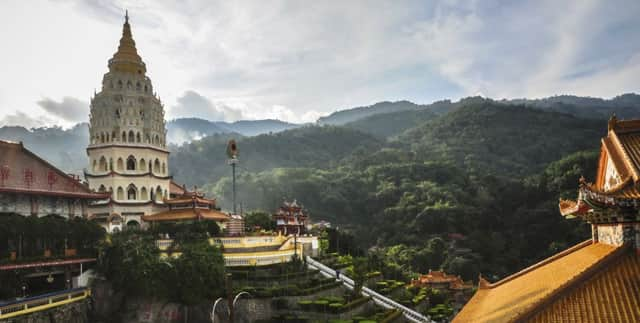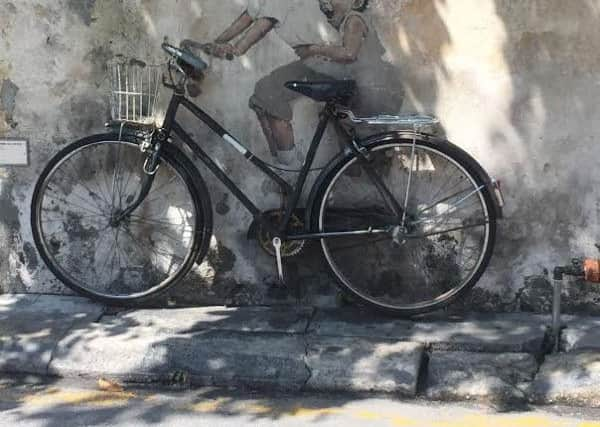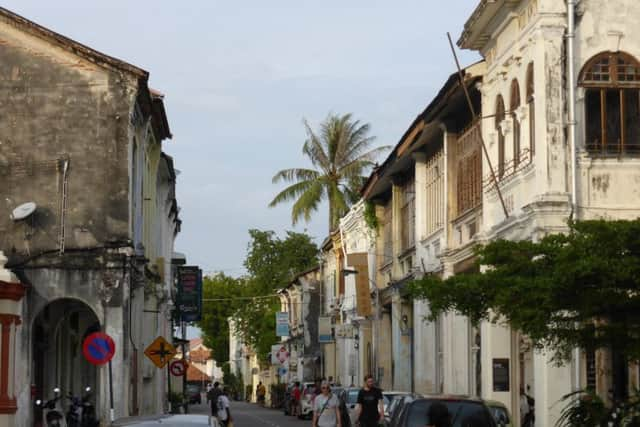Travel: exploring the island of Penang


At the heart of George Town, in the old city, a group of visitors led by a tour guide stops before a mural depicting two children riding a bicycle. The tourists take turns being photographed next to it. The bicycle is real, reclining against the wall, and the painting cleverly completes the illusion of two small children riding it.
This is Armenian Street, one of my favourite places in Penang. I always end up here when I visit, which is at least once a year. My father is Malaysian and my parents have retired there. Armenian Street is set among a maze of narrow, intersecting streets, lined with Chinese shop houses and other colonial-era buildings, many of them beautifully restored. Boutiques and galleries line these streets, along with shops selling chicken rice, dumplings and noodles, Bollywood films and saris, and others occupied by spice grinders, lantern makers and shadow puppet engravers.
Advertisement
Hide AdThe mural that is attracting so much attention, Little Children On A Bicycle, is by Lithuanian-born artist Ernest Zacharevic. Other artists have drawn or painted murals in the lanes that make up this part of the city. This use of public spaces aligns with the cultural philosophy of locals who have been working tirelessly to raise George Town’s profile as a centre for the arts. One such person is Joe Sidek, who runs the George Town Festival.


“Our main mission is to make art accessible,” says Joe. “Art has become so elitist, when in fact it should be about the community.” He explains that the public exhibition of artists’ works means more people are engaged with the art than if it remained behind closed doors.
In 2008, Penang’s state government asked Sidek to organise a one-night event to celebrate George Town’s Unesco listing. “I was given eight days to make a show,” he says. “It was a sort of musical tribute to Penang.” He organised another show in 2009. From these two, the idea of an ongoing, annual event emerged and the first festival was held in 2010. Last year, around 220,000 people attended the festival, which runs throughout August. Penangites are proud of the fact that they can put together an event that includes theatre, music, art, dance, opera and film screenings with relatively little money. The festival relies heavily on state (not federal) government funding. Last year, this amounted to three million ringgit (roughly £550,000).
I was in Penang over Christmas and New Year, and spent some time in the city centre. It was busy with international tourists and visitors from other parts of Malaysia, visiting temples, sitting at cafés watching people go past, or browsing galleries displaying works by local artists, and boutiques selling jewellery, ornaments and souvenirs. Artists who have benefited from the renewal of George Town’s heritage buildings include Malaysian photographer Howard Tan, whose Studio Howard is in Armenian Street. His stunning photographs depict street life here and in other parts of Malaysia, and his series on Penang’s shop houses, printed on coasters and notebooks, have proven a huge hit with visitors.
One thing I like about Penang is that it has retained its authenticity. I had breakfast with my family at a very busy coffee shop where elderly Chinese ladies pushed trolleys laden with dumplings and served tea to customers out of battered kettles. A stroll through town takes you past the kongsi, or clan houses, created by overseas Chinese communities for individuals with the same surname. By the waterfront, there are also six clan jetties made up of houses on stilts. Each jetty in this water village is named after a Chinese clan.


During my last visit, I stopped in China House on Beach Street one afternoon and talked to its owner, Narelle McMurtrie. China House is a unique concept. Spread over three Chinese shop houses, it manages to be everything at once: a gallery space, a cake shop, a restaurant, and a bar. It’s tempting to while away the hours in its cool interior, relaxing beneath the slow-turning fans.
Advertisement
Hide AdOver lime juice and cake – at China House, there are 30 cakes to choose from on any given day – McMurtrie told me a little about herself. She’s been in Malaysia since 1986, when she opened a restaurant in Kuala Lumpur. Nowadays, she and business partner Alison Fraser operate boutique hotels and restaurants in Langkawi and Penang, and McMurtrie divides her time between the two islands.
“Six years ago, downtown Penang was very quiet after 5pm. In the past six years, it has come alive at night,” she says.
Advertisement
Hide AdWith the Unesco listing, she explains, the locals saw the value in their buildings and they reclaimed the city. Foreigners have also been quick to seize opportunities: in recent years, many of the pre-war buildings have been restored and converted into businesses. Over New Year, my husband and I stayed at Campbell House, one of a new breed of heritage-style boutique hotels in George Town. The hotel has 11 rooms, each one unique and tastefully done up with antique furnishings.
One of Penang’s biggest attractions is the food, with a rich cuisine, thanks to a mainly Chinese population, but with Malays and Indians too. In Batu Ferringhi, a popular beach area, there are two large hawker centres where you can feast on satay, seafood and tandoori chicken. It also has a busy night market selling everything from football shirts and Penang watercolours to pashmina shawls and fake designer bags.
What’s also attractive about Penang is its size. It’s manageable. Like other Southeast Asians, Malaysians tend to prefer driving to walking, but nowadays in Penang people are taking to the footpaths more.
“People never used to go by foot in Penang,” says Sidek. “The festival changed that. People are walking and cycling a lot more, interacting with the street.” n
Death In The Rainy Season, by Anna Jaquiery, is published by Mantle, and out now, hardback £14.88, paperback £12.99, kindle £5.39